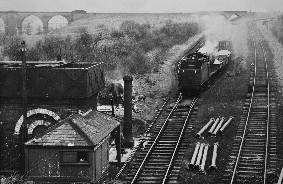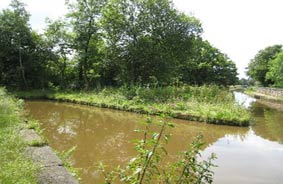Activities and information about the Biddulph Valley Way
Access information
Walkers, wheelers (those who use prams, pushchairs, rollators, manual and powered wheelchairs and mobility scooters), cyclists and horses riders will enjoy the flat well surfaced path of the Biddulph Valley Way. Download the Biddulph Valley Way leaflet (PDF, 5.0MB) for more detailed information. Please note that the access point at Bromley Road/Brookhouse Lane has an A-frame motorbike inhibitor and a steep ramp.
Horses are requested to walk and trot only.
There is a small car park located at the Congleton end of the track near the council yard off Brook Street. Unfortunately this car park is too small to manoeuvre horse boxes on. We are unable to recommend alternative suitable parking as there is none that are under Cheshire East Council's ownership or management.
The Biddulph Valley Way is route 55 of the National Cycle Network. For more information please visit the Sustrans website. Please be mindful of other users as this a shared usage path. Please slow down when passing horses or walkers.
OS Explorer maps are recommended to help you find your own routes and rides in the area. OS Explorer sheet 268 Wilmslow, Macclesfield and Congleton covers this area.
Further walking in the area
The Macclesfield Canal towpath can be reached from the Biddulph Valley Way. It is 42km (26 miles) long and forms the eastern section of the Cheshire Ring Canal Walk, a 156km (97 mile) route. For information on towpath and waterside walks visit the Canal and River Trust website.
The Gritstone Trail is a challenging 56km (35 mile) route stretching from Disley to Kidsgrove. It runs along part of the Biddulph Valley Way, just follow the fingerposts and waymark discs with a 'G' in a footprint. For more information on the trail see the Gritstone Trail page.
Following the Gritstone Trail, through the kissing gate, and across the fields to the east of the Biddulph Valley Way (shown by the Gritstone Trail fingerpost) will take you through Timbersbrook Picnic Area and up to Bosley Cloud, where on a clear day there are brilliant views across Cheshire. For information on Bosley Cloud contact the National Trust.
If walking the Biddulph Valley Way it is well worth taking a short detour for a look at Dane-in-Shaw Pasture Site of Special Scientific Interest, particularly in the summer months when the meadow and pasture are in flower. If you're lucky you may spot a flash of electric blue as a Kingfisher flies past along Dane-in-Shaw Brook or you may hear the yaffle of a Green Woodpecker.
History of the railway line

The Biddulph Valley Railway Line was constructed and financed by the North Staffordshire Railway Company. It ran as a loop from Stoke-on-Trent to Congleton, via Biddulph and Ford Green, rejoining the main Macclesfield to Stafford line at Congleton. The long earth ramp that runs from the Macclesfield Canal aqueduct towards the viaduct was used to carry the line to the main railway network which runs over the Ten Arches. This area of the canal aqueduct was known as Congleton Lower Junction. A branch line also ran from Lower Junction to Brunswick Wharf in Buglawton. The Mossley Halt Station was located by the bridge that spans Reades Lane, and from here coal-miners and furnace-men travelled to and from Black Bull Coal Mine.
The railway line was built to carry freight, mainly coal from the vast North Staffordshire coal fields to Congleton. Instead of travelling back to Staffordshire unladen, Congleton’s speciality export, sand, was transported back into the Potteries. As the main arterial link with the Potteries the line provided the town’s economic lifeblood with the movement of freight of every description from straw to war weapons, and scrap metal to cattle. The branch line was opened to carry coal from the Potteries coalfield to Brunswick Wharf.
On 27 April 1858, the first sod was cut at the works of Mr Heath of Childerplay, near Biddulph. All earthworks were undertaken by picks and shovels wielded by gangs of navvies, who roamed the country stopping whenever work could be found.
A date for completion of the works was imposed on the North Staffordshire Railway Company by the Government and failure to comply meant a heavy fine. In order to avoid such penalties the Company performed a grand opening ceremony on the 3 August, 1859, when the line was only partially completed. A banquet took place in the field overshadowed by the Ten Arches. Distinguished visitors, together with members of the workforce, travelled to a lavish reception in 16 coaches hauled by steam engine, where they were entertained to the sound of brass bands. It was a further twelve months before the line was fully opened to mineral traffic, yet even in its unfinished state thirty two and a half thousand tons travelled over parts of the track.
Although it was the prime aim of the Railway Company to carry freight over the line, plans to run a passenger service were also considered which came to fruition on 1 June 1864. The passenger service was never a financial success. It ran for 60 years, closing on 11 July 1927. The goods side, however, continued for a further 41 years, with the last train leaving Brunswick Wharf at Congleton to travel along the Biddulph Valley Railway on the 1 of April 1968.
The Macclesfield Canal and the Biddulph Valley Railway
 The Macclesfield Canal runs over the Biddulph Valley Way and was opened in 1831. A short, stone lined canal arm branches off the main waterway to the east, close to where the canal runs over the Biddulph Valley Way. The whole of the arm has banks of massive mill grit block construction which indicates that it was actually a glorified wharf rather than a branch canal. The original need for any kind of landing stage to be situated here was that a central loading/unloading point for stone from the prolific Over Rainow and Cloud quarries was necessary, due to the numerous canal and railway bridges which had to be constructed nearby. Later, working in conjunction with the railway, its cargo carrying role escalated and diversified and the canal arm became a thriving merchants wharf. The wharf began to handle huge quantities of silk from Vaudreys Mill at Bath Vale, but, in conjunction with the railway, directly below, goods transferred here between the two transport systems were as diverse as cheese, timber, stone, wine, coal, sugar, ore bricks, sand, silk, cotton and pottery.
The Macclesfield Canal runs over the Biddulph Valley Way and was opened in 1831. A short, stone lined canal arm branches off the main waterway to the east, close to where the canal runs over the Biddulph Valley Way. The whole of the arm has banks of massive mill grit block construction which indicates that it was actually a glorified wharf rather than a branch canal. The original need for any kind of landing stage to be situated here was that a central loading/unloading point for stone from the prolific Over Rainow and Cloud quarries was necessary, due to the numerous canal and railway bridges which had to be constructed nearby. Later, working in conjunction with the railway, its cargo carrying role escalated and diversified and the canal arm became a thriving merchants wharf. The wharf began to handle huge quantities of silk from Vaudreys Mill at Bath Vale, but, in conjunction with the railway, directly below, goods transferred here between the two transport systems were as diverse as cheese, timber, stone, wine, coal, sugar, ore bricks, sand, silk, cotton and pottery.
The canal narrows down to barely ten feet to be carried over the BVW via a stone aqueduct. Immediately prior to the aqueduct, strange metalwork can be seen set in the mill grit blocks which comprise the canal banks, with timber work attached to the heavy metal components. This device is actually an ingenious system of flood control. Just beyond the BVW aqueduct, the canal strikes out onto, arguably it’s most ambitious embankment. A breach in the canal’s bank here would be catastrophic as water would be lost for miles in either direction. The strange device here is actually a set of flood gates which would be activated by the sudden flow of water should disaster threaten. In the event of the flood gates activating, all of the water between the Biddulph Valley Way and Bosley Locks would be saved.
The above information was obtained from:
- History and Guide Congleton, Joan P. Alcock
- Enjoy a Short Historic Walk Along the Biddulph Valley Way, compiled by the Congleton Tourist Information Centre, with information from Mr A. D. Williams
Countryside Ranger Service - Cheshire East Council
Contact Ranger service
rangers@cheshireeast.gov.uk
For Middlewood Way, Jacksons’ Brickworks, Poynton Coppice and Poynton Park: phone 01625 383700
For Tegg’s Nose Country Park: phone 01625 374833
For Lindow Common or Macclesfield Riverside Park: phone 01625 374790
For Brereton Heath Local Nature Reserve, Dane-In-Shaw Pasture SSSI, Croxton Park, Biddulph Valley Way, Timbersbrook Picnic Area, Salt Line, Borrow Pit Meadows, Wheelock Rail Trail, Merelake Way and Rode Heath Rise: phone 01477 534115
For Gritstone Trail: phone 01270 686029
Page last reviewed: 15 April 2025
Thank you for your feedback.